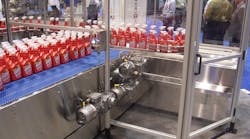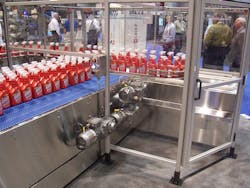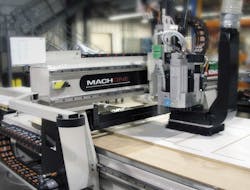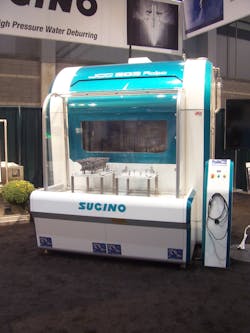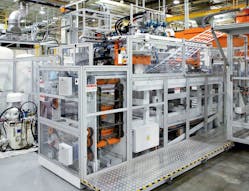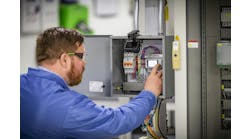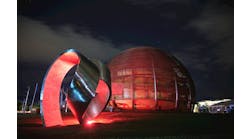Jim Montague is the executive editor for Control, Control Design and Industrial Networking. Email him at [email protected].
Intelligence is just like a Swiss Army knife or other multi-purpose tool that you can apply in different situations to solve many types of problems.
What's different now is that some machines and their controls are being endowed with more of the analytical capabilities of their human counterparts, so they can make better operating decisions and save power and other expenses more quickly and easily. These skills may be rooted in combinations of more powerful microprocessors, better software, more sophisticated robotics, more pervasive networks or cloud-based data processing, but, whatever their source, they're enabling new levels of efficiency for machine builders and their end users.
Savings start with motion
In recent years, probably the most popular way to make machines more energy efficient has been moving from less-flexible induction motors and drives, which are typically on at full power or off, and implementing variable-frequency drives (VFDs) and servo motors, which allow much wider ranges of speeds and power levels and can save a lot power doing the same jobs.
Figure 1: BW Container's AdaptA uses VFDs and servo motors to run containers around a u-turn wheel that lengthens or shortens the containers' single-file path, which improves efficiency, saves energy and helps with queuing and feeding to reduce damage.
Source: Jim Montague
For instance, BW Container Systems, in Lynchburg, Virginia, recently developed its latest AdaptA Series mini-buffering (MB) and multi-lane (ML) conveyor systems for preventing traditional slips, gaps, bumping, pressure, damage and other line inefficiencies among containers running between close-coupled machines. AdaptAMB runs containers around a u-turn wheel that automatically extends or retracts to lengthen or shorten the containers' single-file path, which helps with queuing and feeding to reduce damage (Figure 1). This buffering also helps AdaptA ML, which employs pressureless infeeding to accumulate containers in a transfer station with four to 24 lanes.
"The real estate between machines is at a premium, but this means conveyors often run inefficiently, and so containers need buffering," says Tom Spangenberg, business unit director at BW Container Systems, which includes Barry-Wehmiller's Fleetwood, CBI-Fleetwood, Goldco-Wyard and Ambec divisions. "There's a wide variety of buffering approaches, but users also want easy access and the ability to handle many different products and containers with stability."
To achieve optimal efficiency, simplify control and minimize energy use, AdaptAMB is driven by a 2-hp Nord motor with VFD and a switch chain, while AdaptA ML uses two servo motors and a ControlLogix PLC. Meanwhile, AdaptAMB's wheel uses two motors and two VFDs, and the transfer station relies on three servos. "AdaptA is controlled like a symphony," says Spangenberg. "Mini-buffer's u-turn grows or shrinks as needed, and so users don't have to worry about manually moving devices or handoffs, which used to be very complex."
So far, AdaptA has been implemented by about a dozen food, beverage and consumer product manufacturers, and Spangenberg reports it's achieving 5-20% efficiency gains. "One customer said they saved about $200,000 in damage to their food containers," adds Spangenberg. "However, AdaptA is also transforming us beyond being a machine provider to doing data acquisition for our customers and also delivering higher-level line efficiencies and overall system improvements."
Likewise, Komo Machine in Lakewood, New Jersey, recently needed to build a new, more affordable version of its Mach One GT MTX open-bed, gantry-style router for milling wood, plastics, composites and sheet metal at about 80 sheets per day (Figure 2). Consequently, Komo decided to control its x and y gentry axes and z spindle axis by integrating an IndraMotion MTX micro CNC system and IndraDyn S MSK 60 servo motors from Bosch Rexroth.
See Also: How Better Control Can Pay Off With Improved Machine Efficiency
MTX micro includes high-capacity CNC controls, integrated PLC compliant with IEC 61131-C programming standards, integrated HMI and a 32-bit processor that supports up to six CNC motion axes with control of up to four interpolated axes of motion at any time. Optimized for milling applications, MTX micro supports 2.5D and 3D milling and free positioning of the workpiece coordinate system in space, and it includes many NC capabilities in a compact platform, such as 1,000 NC blocks with look-ahead functions, axis-specific jerk limitations and control of interpolated milling sequences down to the nanometer level.
Figure 2: Komo's Mach One GT MTX router for wood milling uses Bosch Rexroth's IndraMotion MTX micro CNC system to control the router's servo motors, and perform look-ahead functions that accelerate production while maintaining accuracy.
Source: Komo and Bosch Rexroth
"These look-ahead capabilities will allow milling shops to run the machine faster but maintain accurate control of the axes,” says Jeff Erickson, Komo's vice president. "Mach One GT MTX supports a high feed rate of 1,500 in/min, but, as it comes to a corner, it will ramp down to precisely cut a sharp corner without rounding it and then quickly ramp back up to 1,500 in/min, while maintaining control of all the axes. This will enable it to sustain a higher rate of throughput without sacrificing milling quality, enhancing the return on investment for Komo's customers."
Besides reducing milling time, Komo Engineering Manager Steve Ostermann reports that Mach One and MTX micro CNC also save energy by supplying power to all four axes through one interface, rather than separately to each drive. "MTX micro features enough I/O interfaces to support the Mach One’s requirements, and the fully integrated HMI is easier to configure than a separate HMI package," explains Ostermann.
Precise control, duh
Of course, one of the primary paths to efficiency and power savings has always been tighter control and running machines and applications closer to required specifications.
For example, founded in 1926, Gehring Technologies in Ostfildern, Germany, invented and continues to build high-accuracy honing machines for making sure cylinders used in engines, hydraulics, pumps, landing gear and connecting rods are as close to critical tolerances as possible, so all the equipment they go into can optimize the fuel and power they consume and use less lubricating oil. Honing is usually the last step in machining cylinders.
Figure 3: Gehring's Lifehone machines use proprietary software and PLCs to control a two-axis spindle and three-axis table in six- or eight-sided inner columns, and perform up to 16 tasks in one machine.
Source: Jim Montague
The Gehring form-honing process uses tooling with eight to 12 diamond stones and carbide guides, runs at 400 rpm and specializes in creating "negative forms of deformation" to ensure that cylinders will be even closer to perfectly cylindrical when running at high temperatures. Unlike typical honing machines that use a fixed spindle and one- or two-axis table, Gehring's Lifehone line and its year-old Hexahone and Octohone models employ a two-axis spindle and three-axis table in six- or eight-sided inner column to perform up to 16 tasks in one machine, including pre- and post-gauging (Figure 3).
"Our machines automatically compensate for the form and shape of bores to increase accuracy and make them perfectly straight, which takes some burden off their operators," says Thorsten Botzenhardt, Gehring's key account manager. "We also invented a piezo-based feed head that independently extends each of the abrasive stones on the honing tool, which is better than the traditional feed heads that extend all the honing tool fins at once."
These complex components and processes are controlled by Gehring's proprietary Honing Control software and then coordinated by a Siemens Simatic S7 320 DP safety-integrated PLC, which can also interact with users' support robots for loading and unloading the machining center. In-process air gauging provides results to the control and feedback systems, which manages speed, feeds, force control and pressure better than regular numerical controls, according to Botzenhardt. In addition, Lifehone uses Festo's pneumatic safety brakes on guide rails for air-sizing and handling tasks, Lumberg's distribution blocks for proximity switches and minimizing cabling and Profinet protocol for network communications, including remote monitoring and diagnostics.
"Integrating all these functions, such as our safety PLC and regular controls, enables our machines to work faster and more efficiently," adds Botzenhardt.
Robots to the rescue
Along with saving energy while gaining productivity, many builders report that users also want greater flexibility and machines that can adapt and produce more varied types and sizes of products with less changeover than in the past. One way to simultaneously save power and gain flexibility is to use robots for tasks that formerly required multiple integrated components.
For instance, Sugino in Itasca, Illinois, and Toyama, Japan, builds mainly drilling, tapping, machining and high-pressure water deburring equipment, and it recently improved its solutions by implementing robotic functions in some of them. The company's JCC-Wide high-pressure washer runs at up to 7,000 psi, but it was recently updated with robot-type CNC software and renamed JCC-Robo. This upgrade allows Sugino to go beyond the usual x, y and z axes and articulate at horizontal and vertical turning axes, as well, which enable users to wash any area of parts at any desired angle (Figure 4).
"We can get to anywhere on a part with CNC programming, and wash it with 6.4 mega-Pascals, which is almost 1,000 psi," says David Becker, Sugino's sales manager. "Beyond this robotic flexibility, a couple of customers are even simulating putting a standard drill unit, such as an ES2 air/electric, on the end of a Fanuc M710iC robot, so it can also achieve more flexible positioning and work on much larger aircraft, composite or other oversized parts without comparably larger operating or energy costs."
Figure 4: Sugino's JCC-Robo uses CNC programming to articulate at horizontal and vertical turning axes and achieve robot-like flexibility that allows its high-pressure water deburring components to reach any angle of the parts it's washing.
Source: Jim Montague
John Kalkowski, marketing director at Delkor Systems in St. Paul, Minnesota, reports his packaging clients have been demanding similar levels of flexibility and increased productivity. As a result, Delkor also opted for robotic solutions to achieve these goals, merged previously separate operations, and reduced material and energy costs at the same time.
"Several years ago, our users began asking for faster, higher-variety changeovers of multiple packaging formats, so they could handle more unexpected requirements," says Kalkowski. "So, we developed our MSP-200 case packer, which relies on robots to combine several formerly separate tray forming, loading and closing machines into one unified solution. This is especially useful for users with limited space in their plants, who need to handle different sizes of pouches, cartons or cases."
For example, MSP-200 uses a Fanuc M-2iA 3SL delta-style, vision-guided robot to align and set up pouches for pick-and-place, and then a Fanuc M-710iC 50H robot puts them in their cases. Both are coordinated by Fanuc's R-30iB controller and can load up to 150 pouches per minute. “This design allows MSP-200 to work with the corrugated, paperboard and other cartons and cases we form, fill and close, and it also enables it to update individual functions in its production line or add new pieces as needed.”
PC-based smarts show off
Given the intense and growing emphasis on machine intelligence, it was inevitable that PC-based control would arrive to help improve machine and production line efficiency and save energy.
For example, Fabri-Kal in Kalamazoo, Michigan, designs and builds plastic processing and thermoforming equipment for making plastic cups and packaging for yogurt, smoothies, milk shakes and other food products. However, like every machine builder tasked with doing more with less, Fabri-Kal also needed to improve throughput and speed, while reducing energy consumption.
Fabri-Kal uses extruders to form deep-drawing plastic sheets of precisely defined thickness, which are then shaped in a separate deep-drawing machine. In the extruder, PC-based control technology regulates the temperature and pressure, as well as the setpoint for the frequency inverter. Consequently, Fabri-Kal implemented CX2030 and CX1020 embedded PCs from Beckhoff Automation to serve as the control hardware for Fabri-Kal’s machines. In the deep-drawing machine, the PC control platform with Beckhoff's TwinCATNC regulates the drawing unit, along with the composition and separation of the end product. In addition, the PC-based automation technology monitors and documents the factory’s entire production process.
Figure 5: Fabri-Kal's thermoforming machine needed to improve throughput and speed, while reducing energy consumption.
Source: Fabri-Kal and Beckhoff
“What we were aiming for was a dynamic control system with flexible connectivity solutions for linking to the other equipment in the factory, plus the option of capturing and centrally managing large amounts of data in an SQL database," says Dale Michaels, Fabri-Kal's electrical engineer. "Thanks to TwinCAT’s open architecture, we were able to achieve just that. CX2030 is equipped with a 1.5 GHz Intel Core i7 dual-core CPU, which offers high performance in a compact design. Besides handling the PLC and motion control, the embedded PCs also govern the temperature and pressure throughout the production process."
Fabri-Kal also uses EtherCAT for fieldbus networking, which enables communication speeds in the microsecond range.
“EtherCAT significantly improves the performance of our machines,” adds Michaels. “For motion control as well, we're increasingly using AX5000 series EtherCAT servo drives that offer us both high speed and precision.”
Additionally, the I/O stations and drives interspersed along the line of machines are connected via EK1100 EtherCAT couplers. Precise temperature control and performance monitoring ensure efficient use of energy. Precise temperature control plays a key role in the extrusion of high-quality plastics, affecting both resource consumption and product quality.
“Now that we have an integrated PC-based control platform with EtherCAT thermocouple I/O modules, we can precisely maintain the desired temperature on the basis of process data that is captured in real time," adds Michaels. "Integrating PC-based control hardware and software has given us a flexible way to upgrade our machines without coming into conflict with existing control systems as we migrate technologies.”
